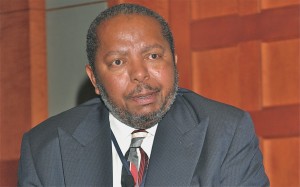Central bank cuts base rate to 11.5%
February 15–Uganda’s Central Bank has reduced its prime lending rate by 50 points to 11.5% in a move aimed at picking up business confidence by making credit slightly cheaper.
While announcing the latest Central Bank Rate (CBR) Prof. Emmanuel Tumusiime-Mutebile, the Governor Bank of Uganda said, the reduction is aimed at reawakening the economy which has slowed to 4.5% from the projected five percent.
“Bank of Uganda judges that a further cautious casting of the monetary policy is warranted to support economic activity,” Mutebile said.
The cut, which is the first of the year, is also expected to help in keeping annual core inflation around the targeted five percent over the medium term which has remained unchanged since December.
In December 2016, BoU reduced the CBR to 12% from 13% in October.
Jibran Qureshi, the Regional East African Economist, for Standard Bank said earlier in the week, “Our view is a cut is not needed; we expect a neutral stance, but we would not be unhappy with a cut either.”
Qureshi had expected BoU not lower the CBR anytime soon, because private sector borrowing is likely to recover in 2017 compared to the hesitancy seen in 2016.
The CBR is what commercial banks use to peg their own lending rates.
Qureshi was speaking at the annual Stanbic Bank Uganda (SBU) Economic Outlook Breakfast that brought together people from both the public and private sector to get an inkling of Uganda’s economy during the next 12 months.
Although BoU predicts that economic growth could remain weak in the remaining part of 2016/17 amidst domestic and external factors, economic prospects for the financial year 2017/18 are optimistic with GDP expected to grow at 5.5 percent driven by improved public infrastructure investment, a recovery in private sector investment and improvement in agricultural production and consumption.
BoU also expects that external shocks on the economy will be softened as global conditions improve.
Not long ago, Christine Lagarde, the International Monetary Fund Managing Director, said in Kampala, “Saharan Africa’s growth in 2016 was the lowest in 20 years at about 1.5 percent, and is projected to reach only 2.7 percent in 2017. Commodity exporters have experienced a particularly rapid deceleration. The policy response in many African countries has been delayed and incomplete. So the end result has been uncertainty. Private investment is falling, stifling new sources of growth.”
She said in a public lecture that under-developed infrastructure is a permanent brake on growth. “ It prevents businesses from connecting to local, regional, and global markets, and limits their willingness to invest. Ultimately, infrastructure bottlenecks will slow the structural transformation and industrialization that Uganda aspires to.”
She said, “The government’s strategy to scale up infrastructure investment is well conceived. It is intended to lift growth while maintaining debt at a sustainable level.”
But to achieve these goals Lagarde said investment must be efficient. “That calls for strong institutions to keep mismanagement in check and ensure maximum value for money. There is work to be done. The World Bank has estimated that, if Uganda’s investments were better managed, annual growth could be 2.5 percentage points higher,” she said.


 100+ Accelerator selects Ugandan startup Yo-Waste to pilot glass recycling at Nile Breweries
100+ Accelerator selects Ugandan startup Yo-Waste to pilot glass recycling at Nile Breweries
 Boeing’s record SAF purchase supports airlines decarbonisation efforts
Boeing’s record SAF purchase supports airlines decarbonisation efforts
 Uganda Airlines likely to miss Spirit A320neo delivery slots
Uganda Airlines likely to miss Spirit A320neo delivery slots
 Rolls-Royce Pearl 10X engine takes flight
Rolls-Royce Pearl 10X engine takes flight
 Unpacking results-based financing: balancing strengths with weaknesses
Unpacking results-based financing: balancing strengths with weaknesses
 Big fish in small pond Stanbic notches up $100m profit for 2023 topping previous figure by 15%
Big fish in small pond Stanbic notches up $100m profit for 2023 topping previous figure by 15%
